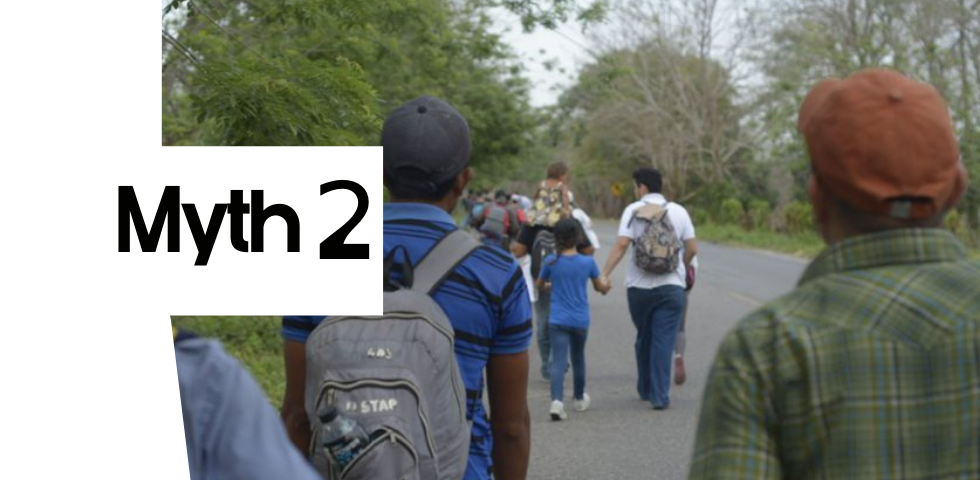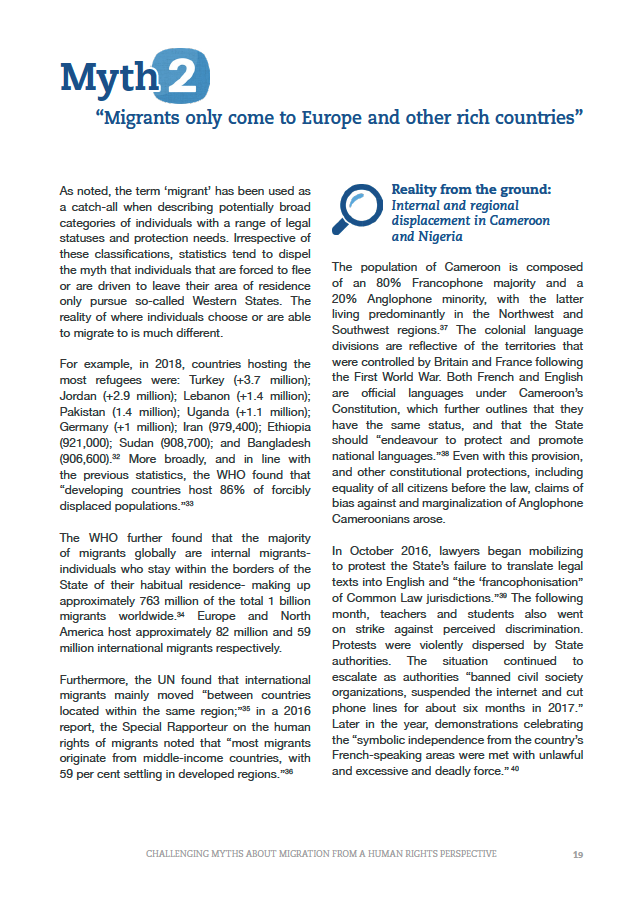“Migrants only come to Europe and other rich countries”
As noted, the term ‘migrant’ has been used as a catch-all when describing potentially broad categories of individuals with a range of legal statuses and protection needs. Irrespective of these classifications, statistics tend to dispel the myth that individuals that are forced to flee or are driven to leave their area of residence only pursue so-called Western States. The reality of where individuals choose or are able to migrate to is much different.
For example, in 2018, countries hosting the most refugees were: Turkey (+3.7 million); Jordan (+2.9 million); Lebanon (+1.4 million); Pakistan (1.4 million); Uganda (+1.1 million); Germany (+1 million); Iran (979,400); Ethiopia (921,000); Sudan (908,700); and Bangladesh (906,600). More broadly, and in line with the previous statistics, the WHO found that “developing countries host 86% of forcibly displaced populations.
The WHO further found that the majority of migrants globally are internal migrants individuals who stay within the borders of the State of their habitual residence- making up approximately 763 million of the total 1 billion migrants worldwide. Europe and North America host approximately 82 million and 59 million international migrants respectively.
Furthermore, the UN found that international migrants mainly moved “between countries located within the same region;” in a 2016 report, the Special Rapporteur on the human rights of migrants noted that “most migrants originate from middle-income countries, with 59 per cent settling in developed regions.”

Reality from the ground
Internal and regional displacement in Cameroon and Nigeria
The population of Cameroon is composed of an 80% Francophone majority and a 20% Anglophone minority, with the latter living predominantly in the Northwest and Southwest regions. The colonial language divisions are reflective of the territories that were controlled by Britain and France following the First World War. Both French and English are official languages under Cameroon’s Constitution, which further outlines that they have the same status, and that the State should “endeavour to protect and promote national languages.” Even with this provision, and other constitutional protections, including equality of all citizens before the law, claims of bias against and marginalization of Anglophone Cameroonians arose.
In October 2016, lawyers began mobilizing to protest the State’s failure to translate legal texts into English and “the ‘francophonisation” of Common Law jurisdictions.” The following month, teachers and students also went on strike against perceived discrimination. Protests were violently dispersed by State authorities. The situation continued to escalate as authorities “banned civil society organizations, suspended the internet and cut phone lines for about six months in 2017.” Later in the year, demonstrations celebrating the “symbolic independence from the country’s French-speaking areas were met with unlawful and excessive and deadly force.”
Violence between Cameroon authorities and armed separatist groups spurred displacement. In November 2018, the United Nations Office for the Coordination of Humanitarian Affairs (UN OCHA) estimated that at least 437,000 individuals were “internally displaced in the South-West, North-West and in neighbouring departments due to hostilities between armed groups and security forces.” During the same period, the UN reported that over 26,000 Cameroonians had fled to Nigeria. By February 2020, 679,000 individuals were internally displaced in the Northwest and Southwest regions, and approximately 60,000 individuals were seeking asylum in Nigeria.
While instability in Cameroon was a driver of displacement for its nationals, the State also received asylum-seekers. This was spurred by attacks launched by Boko Haram throughout Africa’s Lake Chad Basin, which includes parts of Cameroon, Chad, Niger, and Nigeria. Large-scale displacement has occurred throughout the region. In February 2020, the UNHCR estimated that there were 2,617,808 internally displaced persons in the Lake Chad Basin, with Nigerians accounting for the overwhelming majority of IDPs (at upwards of 2 million). Amongst those displaced, Cameroon hosted the majority of Nigerian refugees, with approximately 105,923 of the total 107,840 of the Nigerian refugees in Cameroon in the Far North region.
Notably, the high number of refugees persists despite the signing of a tripartite agreement between Cameroon, Nigeria, and the UNHCR in 2017 to facilitate the voluntary return of Nigerian refugees in Cameroon. Even with the agreement in place, Human Rights Watch documented abuses faced by Nigerian asylum seekers and refugees, including their forcible return to Nigeria by Cameroonian authorities.
Freedom of Movement
State Obligations:
Article 12 of the International Covenant on Civil and Political Rights (ICCPR) affirms:
“1. Everyone lawfully within the territory of a State shall, within that territory, have the right to liberty of movement and freedom to choose his residence.
- Everyone shall be free to leave any country, including his own.
- The above-mentioned rights shall not be subject to any restrictions except those which are provided by law, are necessary to protect national security, public order (ordre public), public health or morals or the rights and freedoms of others, and are consistent with the other rights recognized in the present Covenant.
- No one shall be arbitrarily deprived of the right to enter his own country.”
Article 13 of ICCPR goes on to note:
“An alien lawfully in the territory of a State Party to the present Covenant may be expelled therefrom only in pursuance of a decision reached in accordance with law and shall, except where compelling reasons of national security otherwise require, be allowed to submit the reasons against his expulsion and to have his case reviewed by, and be represented for the purpose before, the competent authority or a person or persons especially designated by the competent authority.”
The UN Human Rights Committee has held that restrictions on freedom of movement must “conform to the principle of proportionality; they must be appropriate to achieve their protective function; they must be the least intrusive instrument amongst those which might achieve the desired result; and they must be proportionate to the interest to be protected.”
Global Compact on Migration
- Objective 5: “Enhance availability and flexibility of pathways for regular migration”
- Objective 17: “Eliminate all forms of discrimination and promote evidence-based public discourse to shape perceptions of migration”

Franciscans International, the NGO of the Franciscan Family to the United Nations, has prepared this material. The publication presented in this post is an extract from the document “Breaking down the Walls, Myth 2: Migrants only come to Europe and other rich countries” you can do it here ↓


